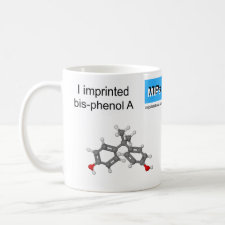
Authors: Yin YM, Chen YP, Wang XF, Liu Y, Liu HL, Xie MX
Article Title: Dummy molecularly imprinted polymers on silica particles for selective solid-phase extraction of tetrabromobisphenol A from water samples.
Publication date: 2012
Journal: Journal of Chromatography A
Volume: 1220
Issue: (1)
Page numbers: 7-13.
DOI: 10.1016/j.chroma.2011.11.065
Alternative URL: http://www.sciencedirect.com/science/article/pii/S002196731101781X
Abstract: Surface molecular imprinted polymers (MIPs) on silica gel particles for highly selective recognition of tetrabromobisphenol A (TBBPA) were prepared by a sol - gel process. Diphenolic Acid (DPA) and bisphenol A (BPA), whose structures were similar to that of TBBPA were selected as dummy template molecules, and 3-aminopropyltriethoxysilane (APTES) and tetramethoxysilane (TEOS) were chosen as functional monomer and cross-linker, respectively. The obtained materials were characterized by FT-IR with diffuse reflectance accessory and the results indicated polymers were successfully grafted on the surface of silica gel supporters. The maximum static adsorption capacities for TBBPA of the DPA-MIPs, BPA-MIPs and non-imprinted polymers (NIPs) were 45, 38 and 22 mg g-1 respectively, and the results of dynamic adsorption showed that the adsorption equilibrium can be achieved within 15 min for DPA- and BPA-MIPs. Both the DPA- and BPA-MIPs have higher selectivity for TBBPA than that of NIP when they are used as the sorbents for the solid phase extraction (SPE), while the adsorption property of DPA-MIPs was superior to that of BPA-MIPs at low concentration levels of TBBPA. The results indicated DPA-MIPs had more high affinity binding sites for TBBPA, which demonstrated that the strong interactions between the template and the functional monomer were favorable to form high affinity binding sites and improve the selectivity of the polymers. A corresponding analytical method for determination of the TBBPA residues in environmental samples was developed. The recoveries of TBBPA in tap water, river water and lake water were in the range from 85% to 97% with relative standard deviations below 7%, and its limit of detection can reach 2 ng mL-1
Template and target information: tetrabromobisphenol A, TBBPA, Diphenolic Acid, DPA, bisphenol A, BPA, dummy template
Author keywords: dummy template, Surface molecular imprinted polymers, Tetrabromobisphenol A, Solid-phase extraction, Diphenolic Acid



Join the Society for Molecular Imprinting

New items RSS feed
Sign-up for e-mail updates:
Choose between receiving an occasional newsletter or more frequent e-mail alerts.
Click here to go to the sign-up page.
Is your name elemental or peptidic? Enter your name and find out by clicking either of the buttons below!
Other products you may like:
 MIPdatabase
MIPdatabase









